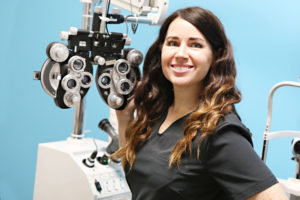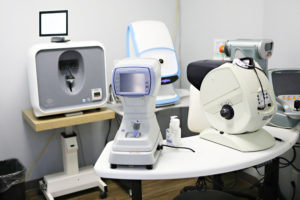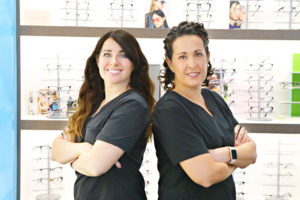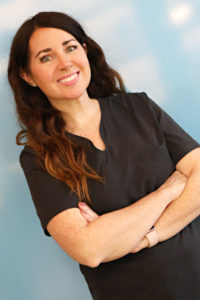May 17, 2021
Vaughn Brinegar, OD, Ultimate Eye Care, Austin, TX
Because I’ve gone through this process with my child, I can offer parents a unique perspective when presenting these treatment options to them. I know what it’s like to have mishaps with lenses, have questions about the process, or generally struggle with the transition to these treatments.

I’ve been practicing optometry for the better part of two decades, but it wasn’t until about five years ago that I took the plunge and started offering myopia management treatments to children. As a family-run business (I practice with my sister, Victoria DeFeo, OD), another family connection spurred my decision to learn more about myopia management.
When my son was 10, I noticed — as his mom and his doctor — that he was experiencing big changes to his prescription. At that point, I knew I wanted to start taking steps to slow his prescription from progressing even further. As someone who can’t make it too far out of the bedroom without my glasses, I knew he’d be headed down the same path, and I wanted to learn how I could control his myopia progression, not just for him but also to help other patients in our practice.
I started my son with soft multifocal lenses — CooperVision’s Biofinity lenses. He thought I had gotten his prescription wrong for quite some time because he couldn’t tolerate the distance blur. That was the push I needed to get real, formal training in myopia management and see other treatment options. We started by attending the Boot Camp at Vision by Design. I had heard such positive feedback about the meeting, and all of it was true; we left there feeling so excited to go back to work and put all of these tools into practice with our patients — and with my son.
Personal Experience Plays a Role
When I start myopia management treatment, I begin with the child’s axial length measurement. We use DGH Technology’s Scanmate A, and based on the reading, the patients’ age, and how they’ve progressed since their last eye exam, we can determine a course of treatment. I like to start with one treatment and see how effective it is, depending on how the patient progresses. We may incorporate another treatment modality down the road.

Since starting myopia management treatment, fitting patients for orthokeratology lenses has emerged as my go-to for many patients. I always go through all available treatment options with patients — OrthoK lenses (I use EyeSpace and Contex for custom designs), multifocal lenses such as NaturalVue, MiSight 1 day, and SpecialEyes, or topical atropine. Many patients and their parents gravitate toward OrthoK lenses because it gives kids freedom during the day, and they never have to worry about leaving the house and making sure their lenses are in.
Because I’ve gone through this process with my child, I can offer parents a unique perspective when presenting these treatment options to them. I know what it’s like to have mishaps with lenses, have questions about the process, or generally struggle with the transition to these treatments. OrthoK was the second treatment I tried on my son, and there was a lot of trial and error. His first set of lenses fell out of his eye, hit the ground, and broke, and his second set was a better fit, but they caused mild irritation, which led to another round of fittings to find the right set. He’s now been wearing OrthoK lenses for the last four years, and his axial length and refraction have been stable ever since. I’ve stabilized his prescription at -2.25 in his right eye and -1.25 in his left eye.
My son was my most challenging patient. He loved his glasses, and he wasn’t too happy about sleeping in lenses. However, going through these experiences with him gave me the confidence I needed to serve my myopia patients better. Now, I’m so much better at finding creative ways to help my patients enjoy the process.
Providing Education and Support
As both a parent and an OD, one of my biggest goals is clearly communicating with my patients, educating parents on the risks of myopia and the benefits of treatment, and encouraging them to use me as a resource whenever they need support. I always want to be as thorough as possible to ensure that no one leaves the appointment and hears about a potential treatment option from a friend or family member. In addition to sending parents’ home with the specifics of their child’s prescription and myopia progression, where their vision is headed based on those figures, and what we can do to slow down their progression, I email them resources, such as Dr. D’s Ted Talk or CooperVision’s Myopia Simulator.

Vaughn Brinegar, OD, (left) and Victoria DeFeo, OD
After the first appointment, I schedule a video call with parents, and we can talk through all of their questions without feeling like we need to rush through an in-person appointment. I think this helps parents feel more at ease and supported through these treatments with their children. As a parent who has gone through these treatments with my child, I know it can be scary to have a kid sleeping in contact lenses. There’s a learning curve to putting the lenses in and taking them out, and I want my patients to know that they’re not alone in this process. They have access to me 24 hours a day for questions, support, or anything they need.
Technology Can Improve Efficiency
Finding the right equipment for myopia management is another crucial component to successfully treating patients, and the Medmont Meridia has streamlined the way we conduct exams.
When I’m treating my myopia patients, I can use the Medmont to take anterior segment or fluorescein photos, and I do most of my exam on this one device. We do many custom-fit contact lenses with our myopia patients, and using the Medmont has made me so much more accurate on my first try. It also helps to educate patients and their parents on myopia and the value of myopia management treatments.
A Rewarding Experience
Because my myopia management journey has such personal roots, I wanted to be sure that I would do it right before I started. Now five years in, the most rewarding part is seeing kids’ faces light up the first day you put them in a pair of contact lenses, and their vision is clear. Since we started using the Meridia, our maps are so good, and the lenses are so custom that many kids walk out that first day with 20/20 vision. When parents are happy, and kids are happy, that’s the best feeling.
This is an inspiring time for optometry and myopia management. There’s so much education available, and we’re able to expand our comfort zones on treating myopic patients. I think that by the next generation of kids, myopia management will be something that’s expected of ODs, and if we’re not offering solutions to slow a child from progressing, then we’re missing the boat.

Vaughn Brinegar, OD, graduated from Southern College of Optometry in 2003. She has been in private practice with her sister, Victoria DeFeo, OD, at Ultimate Eye Care since May 2005 in Austin, Texas. Their office is in a suburban location with a lot of young families, so they emphasize myopia management.













